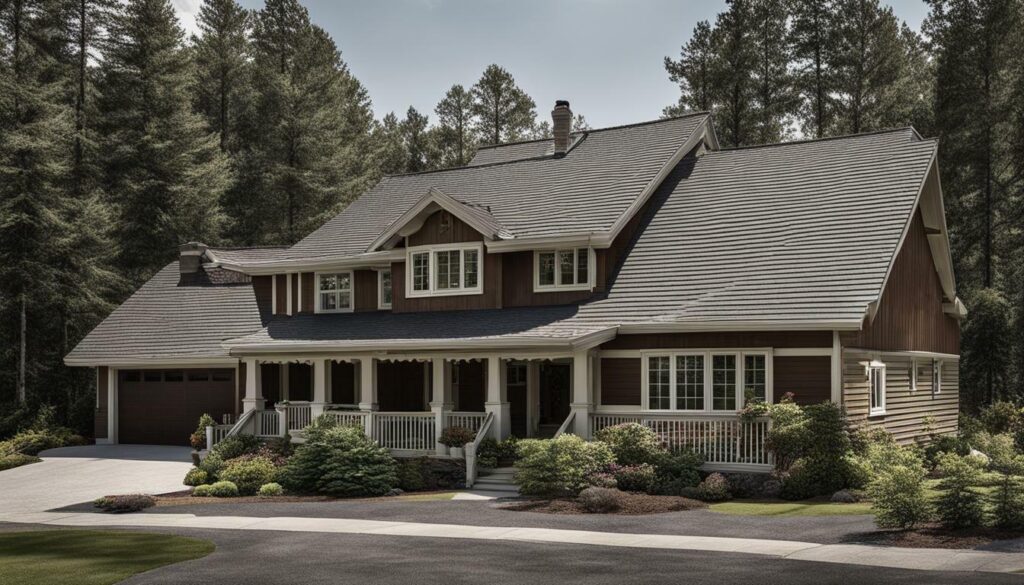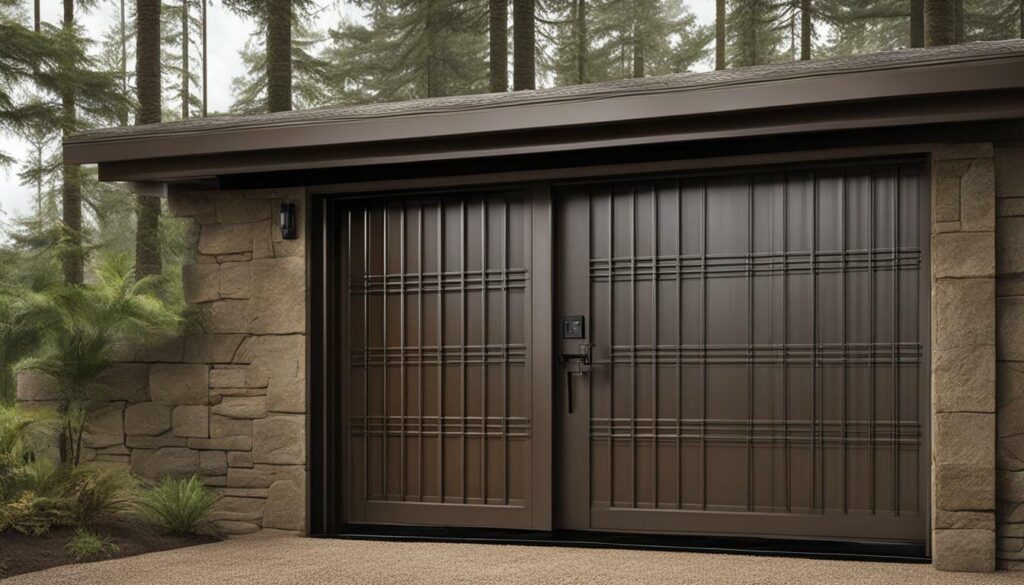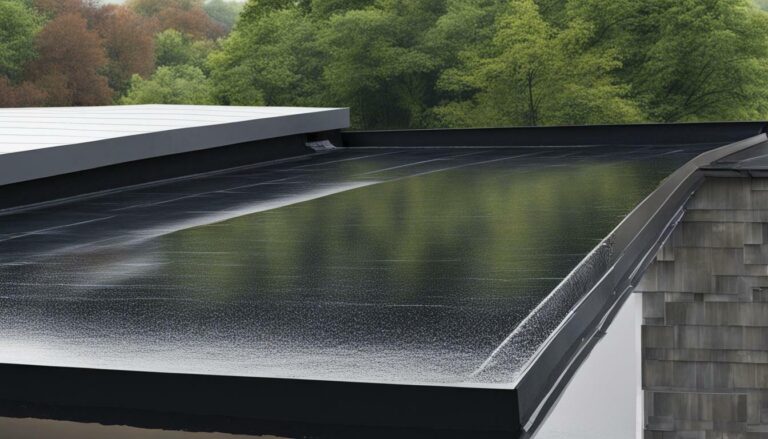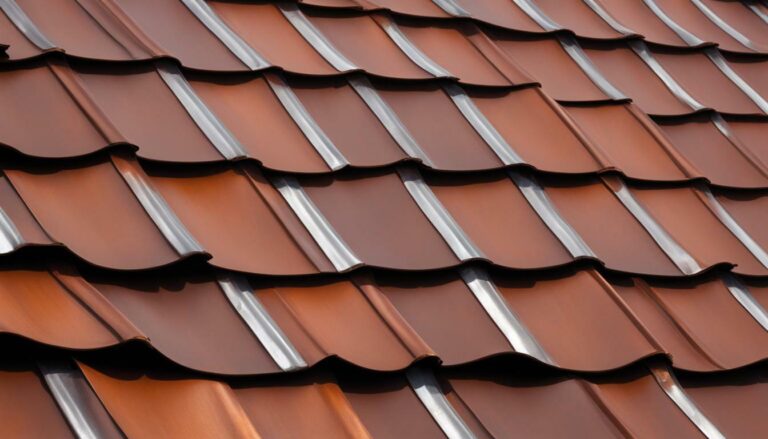Guide to Securing Roofs Against Strong Winds: Protect Your Home
Securing your roof against strong winds is crucial in protecting your home from potential damage and ensuring its stability during severe weather conditions. High winds can cause significant harm to roofs, leading to costly repairs and compromising the safety of your property. To safeguard your home, it is essential to invest in wind-resistant roofing materials and implement effective protection measures.
Key Takeaways:
- Wind-resistant doors and impact-resistant glass provide better protection against high winds and blowing debris.
- Impact-resistant doors offer improved security, sound insulation, temperature insulation, and potential insurance premium discounts.
- Standard doors can be reinforced by inspecting for cracks or damaged hardware, replacing screws with longer ones, ensuring proper sealing, and adding deadbolts or bolts to French-style double doors.
- Windows are vulnerable during high winds, and using high-impact glass is recommended for safety, security, and energy-efficiency benefits.
- Alternatives to high-impact glass include plywood, hurricane film, and shutters.
- Proper pruning of tree branches and strategic landscaping can help create windbreaks to protect your roof.
- Weatherproofing doors and windows and moving vehicles to sheltered areas are additional precautions to consider.
- Planning ahead and being prepared for storms is crucial, including inspecting roofs for weak areas and considering hail-resistant roofing or a shutter system for skylights.
Understanding the Impact of Strong Winds on Roofs
Strong winds can cause significant damage to roofs, ranging from minor shingle damage to complete roof failure, making it imperative to secure your roof against these powerful forces. In areas prone to high winds, it is crucial to implement effective protection measures to safeguard the integrity of your roof and protect your home from wind damage.
Common types of wind damage to roofs include missing or lifted shingles, damaged flashing, leaks, and even structural collapse in extreme cases. These issues not only compromise the safety and structural stability of your home but also result in costly repairs and potential interior damage from water intrusion.
To best secure your roof against strong winds, it is recommended to use wind-resistant roofing materials and techniques. Wind-resistant roofing materials, such as asphalt shingles with high wind ratings or metal roofs, are designed to withstand the forceful impact of wind and reduce the risk of damage. Additionally, proper installation techniques, such as using nails instead of staples and ensuring adequate roof and edge fastening, can enhance the wind resistance of your roof.

| Type of Damage | Description |
|---|---|
| Missing Shingles | Shingles that have been blown off or torn loose by strong winds, leaving the underlying roof exposed to the elements. |
| Lifted Shingles | Shingles that have been partially raised or lifted from their intended position, creating gaps where wind-driven rain can penetrate. |
| Damaged Flashing | Flashing, which is used to seal gaps where the roof meets other surfaces (e.g., chimneys, vents), can become damaged or dislodged by high winds, leading to leaks. |
| Structural Collapse | In extreme cases, strong winds can cause the entire roof structure to collapse, resulting in extensive damage to the home. |
In addition to securing the roof itself, it is essential to reinforce other vulnerable areas of your home, such as doors and windows, to further protect against wind damage. Using wind-resistant doors, such as those with reinforced frames and impact-resistant glass, can help prevent wind-driven debris from breaking through and causing damage to the interior of your home. Window protection options, such as impact-resistant glass or temporary measures like plywood, hurricane film, or shutters, can also provide an extra layer of defense against strong winds.
By understanding the impact of strong winds on roofs and implementing best practices for securing your roof in windy areas, you can significantly reduce the risk of wind damage to your home. Taking proactive measures to protect your roof and reinforcing vulnerable areas can help ensure the safety, integrity, and longevity of your home in the face of powerful wind forces.
Wind-Resistant Roofing Materials and Solutions
Choosing the right roof materials that are engineered to withstand strong winds is essential in fortifying your home against potential wind damage. These materials are specifically designed to withstand the force of high winds, ensuring the integrity of your roof and protecting your home. Here are some wind-resistant roofing materials and solutions to consider:
- Impact-Resistant Shingles: These shingles are made of durable materials, such as asphalt or metal, and are designed to withstand strong winds. They are constructed with multiple layers and reinforced with adhesive strips to provide added strength and resistance.
- Metal Roofing: Metal roofs are known for their durability and ability to withstand extreme weather conditions. They can effectively resist wind uplift, as metal panels are securely fastened to the roof structure, preventing them from being lifted off by strong winds.
- Composite Roofing: Composite shingles are made of a combination of materials, such as fiberglass, asphalt, and recycled polymers. They are designed to provide superior wind resistance while maintaining an aesthetically pleasing appearance.
In addition to these roofing materials, there are also other solutions that can help enhance the wind resistance of your roof:
- Roofing Adhesive: Applying roofing adhesive along the edges and seams of your roof can help strengthen the bond between the shingles and prevent them from being lifted by strong winds.
- Roof Deck Reinforcement: Reinforcing the roof deck with additional bracing or sheathing can provide added stability and resistance against wind uplift.
- Proper Installation: Hiring a professional roofing contractor who specializes in wind-resistant roofing installations is crucial. They have the knowledge and expertise to ensure proper installation techniques are followed, maximizing the wind resistance of your roof.
Table: Wind-Resistant Roofing Materials Comparison
| Roofing Material | Key Features | Estimated Lifespan |
|---|---|---|
| Impact-Resistant Shingles | Durable construction, reinforced adhesive strips | 20-30 years |
| Metal Roofing | Securely fastened panels, high wind uplift resistance | 40-70 years |
| Composite Roofing | Combination of materials for strength and aesthetics | 25-35 years |
By investing in wind-resistant roofing materials and implementing appropriate solutions, you can significantly reduce the risk of wind damage to your home. Consult with a professional roofing contractor to determine the most suitable options for your specific needs and ensure the long-term protection and safety of your property.

Doors are vulnerable entry points during high winds, but by using wind-resistant doors and implementing reinforcement measures, you can enhance your home’s resistance to powerful gusts. Wind-resistant doors provide added security and protection against strong winds, reducing the risk of structural damage and potential breaches. Additionally, wind-resistant doors offer benefits such as improved sound insulation, temperature insulation, and potential insurance premium discounts.
When it comes to reinforcing standard doors, there are several steps you can take to enhance their resistance to high winds. Start by inspecting the door for cracks, damaged hardware, or signs of wear and tear. It is recommended to replace shorter screws with longer ones to secure the hinges and strike plates more effectively. Ensure that the door is properly sealed, as this helps to prevent wind-driven rain and debris from entering your home. Adding deadbolts or bolts to French-style double doors provides an extra layer of security and reinforcement.
| Benefits of Wind-Resistant Doors | Benefits of Impact-Resistant Glass |
|---|---|
|
|
If you are looking for even greater protection for your home, consider upgrading to impact-resistant glass for your windows. Impact-resistant glass is designed to withstand high winds and flying debris, reducing the risk of shattered windows and potential intrusions. In addition to improved safety, impact-resistant glass offers benefits such as enhanced sound insulation, increased security, UV ray reduction, lower energy costs, lower insurance costs, and increased home value.
Alternatively, if impact-resistant glass is not within your budget, temporary measures such as plywood, hurricane film, or shutters can be used to protect windows during strong wind events. These options provide an additional layer of defense and can help prevent damage caused by flying debris. When choosing any window protection method, it is important to follow manufacturer guidelines and ensure proper installation for maximum effectiveness.
Quote: Proper pruning and strategic landscaping
Proper pruning of tree branches can help reduce the risk of tree-related damage to your roof during high winds. By creating windbreaks with strategic landscaping, you can further protect your home from the full force of strong winds.
Remember, in addition to reinforcing doors and windows, it is also important to weatherproof them. Proper sealing, reinforcing vulnerable areas, and utilizing temporary measures like hurricane film or shutters can help enhance their resistance to strong winds. Furthermore, it is advisable to move vehicles to sheltered areas and secure loose items in preparation for storm events. By planning ahead and taking these precautionary measures, you can better protect your home and minimize potential damage caused by strong winds.

Windows are susceptible to wind damage, but incorporating impact-resistant glass or alternative window protection measures can significantly enhance your home’s ability to withstand strong winds. Impact-resistant glass offers a range of benefits, including increased safety, sound insulation, improved security, UV ray reduction, lower energy costs, potential insurance premium discounts, and increased home value.
Using impact-resistant glass in your windows provides an added layer of protection against the strong forces associated with high winds. This type of glass is specially designed to resist shattering, even when subjected to intense pressure or impact. It is constructed by sandwiching a durable interlayer between two layers of glass, which helps to maintain the integrity of the window even if the glass cracks.
Alternative window protection options include plywood, hurricane film, and shutters. Plywood can be secured over windows when a storm is approaching to provide temporary protection. Hurricane film is a transparent adhesive film that can be applied directly to the glass to prevent it from shattering upon impact. Shutters, whether manual or automatic, can be installed on the exterior of the windows and closed during high wind events to shield the glass and prevent damage.
When considering window protection, it is essential to consult with a professional to determine the best solution for your specific needs. They can assess the vulnerability of your windows, evaluate the local wind conditions, and recommend appropriate measures to enhance their resistance to strong winds.

| Benefits of Impact-Resistant Glass: |
|---|
| Safety: Resists shattering even under intense pressure or impact. |
| Sound Insulation: Helps to reduce outside noise, creating a quieter indoor environment. |
| Improved Security: Provides an additional barrier against potential intruders. |
| UV Ray Reduction: Blocks harmful UV rays from entering your home, protecting furniture and reducing fading. |
| Lower Energy Costs: Enhances insulation, reducing heat transfer and helping to maintain desired indoor temperatures. |
| Potential Insurance Premium Discounts: Some insurance companies offer discounts for homes with impact-resistant windows. |
| Increased Home Value: Impact-resistant windows are a desirable feature that can attract potential buyers and increase property value. |
Landscaping and Tree Maintenance for Wind Protection
Proper landscaping and tree maintenance play a crucial role in safeguarding your roof against strong winds and minimizing the risk of wind-driven debris. Creating a strategic windbreak using trees and shrubs can help reduce the force of the wind on your roof, preventing potential damage. Additionally, regular tree maintenance, such as pruning dead or weak branches, can minimize the risk of them being torn off during a storm and causing harm to your roof or property.
When selecting trees for your yard, opt for those with strong root systems and sturdy trunks that can withstand high winds. Trees like oak, maple, and pine are known for their wind-resistant qualities and can provide an effective barrier against strong gusts. It’s also essential to choose native tree species that are well-suited to your region’s climate, as they are more likely to thrive and withstand adverse weather conditions.
Furthermore, consider installing a green roof or rooftop garden, which can act as an additional layer of protection against strong winds. The vegetation on the roof absorbs some of the wind’s energy, reducing its impact on the building and helping to maintain roof integrity. Green roofs also offer other benefits, such as improved insulation, reduced environmental impact, and enhanced aesthetics.
Table: Wind-Resistant Trees for Your Yard
| Tree Species | Wind-Resistance Rating |
|---|---|
| Oak | High |
| Maple | High |
| Pine | High |
| Cypress | Moderate |
| Juniper | Moderate |
| Redbud | Moderate |
| Crabapple | Low |
| Cherry | Low |
To ensure the long-term effectiveness of your windbreak and maintain roof integrity in strong wind conditions, it’s important to regularly inspect and maintain your landscaping. Remove any dead or damaged trees promptly and monitor the health of existing trees to address potential issues before they become a problem. By investing in proper landscaping and tree maintenance, you can fortify your roof against strong winds and protect your home from potential damage.

Weatherproofing Doors and Windows
Ensuring proper weatherproofing of doors and windows is essential in securing your home against the damaging effects of strong winds and severe weather conditions. When it comes to protecting your home, wind-resistant doors and windows are key components that can provide added security and peace of mind.
One effective solution for enhancing the wind resistance of doors is to install impact-resistant doors. These doors are specifically designed to withstand high winds and flying debris, offering superior protection for your home. Impact-resistant doors not only provide security but also offer sound insulation, temperature insulation, and potential insurance premium discounts.
If you have standard doors in your home, there are several steps you can take to reinforce them against strong winds. Start by inspecting the doors for any cracks or damaged hardware, as these can weaken their resistance to wind. Replace any worn or inadequate screws with longer ones to ensure better anchoring. Additionally, make sure all gaps and openings around the doors are properly sealed to prevent wind infiltration. For French-style double doors, consider adding deadbolts or bolts at the top and bottom for added security.
Windows are another vulnerable area during high winds. Installing high-impact glass is highly recommended to protect against flying debris and strong gusts. High-impact glass offers numerous benefits, including increased security, sound insulation, improved energy efficiency, UV ray reduction, potential insurance cost savings, and increased home value. Alternatively, you can use plywood, hurricane film, or shutters as temporary measures to shield your windows from wind damage.

| Benefits of Impact-Resistant Glass | Benefits of High-Impact Glass Alternatives |
|---|---|
| Increased security | Emergency protection during storms |
| Sound insulation | Temporary solution if impact-resistant glass is not available |
| Improved energy efficiency | Cost-effective option for short-term window protection |
| UV ray reduction | Easy installation and removal |
| Potential insurance cost savings | Can be reused for future storms |
| Increased home value |
Proper Tree Maintenance and Landscaping
In addition to wind-resistant doors and windows, it’s essential to consider the role of landscaping and tree maintenance in protecting your home from strong winds. Properly pruned trees can act as natural windbreaks, reducing the force of wind gusts around your property. Regular tree inspections and trimming of branches can help prevent potential damage to your roof during storms.
When it comes to landscaping, strategic placement of shrubs, hedges, and fences can create additional wind barriers, further protecting your home. Consider consulting with a professional landscaper to design a wind-resistant landscape plan tailored to your property.
To summariz
Preparing for Strong Wind Events
Being prepared for strong wind events is crucial in minimizing potential damage to your roof and ensuring the safety of your home and belongings. By taking proactive measures, you can strengthen your roof’s resilience and protect your property from the destructive force of high winds.
Start by conducting a thorough inspection of your roof to identify any weak areas that may be susceptible to wind damage. Look for loose or damaged shingles, as well as any signs of wear and tear. Addressing these issues before a storm hits can help prevent further damage and ensure your roof can withstand strong winds.
Consider investing in hurricane-resistant roofing materials that are specifically designed to withstand high winds. These materials, such as impact-resistant shingles or metal roofing, are built to withstand wind speeds typically associated with hurricanes. By choosing these windstorm proof roofing materials, you can provide an added layer of protection to your home and increase its resilience against strong winds.
Additionally, it is important to secure loose items in your yard that could become projectiles during a storm. This includes patio furniture, potted plants, and outdoor decorations. Store these items in a safe location or secure them with heavy objects or tie-downs to prevent them from being swept away by the wind.
Remember, preparation is key when it comes to safeguarding your home against strong winds. By implementing these measures and investing in hurricane-resistant roofing, you can proactively protect your property and have peace of mind during severe weather events.
Conclusion
Securing your roof against strong winds is an essential step in protecting your home from potential damage and ensuring its long-term integrity in severe weather conditions. By implementing the recommended measures and investing in wind-resistant materials, you can fortify your home’s first line of defense against powerful gusts.
When it comes to doors and windows, opting for wind-resistant options such as impact-resistant glass can provide numerous benefits. Impact-resistant doors not only offer better security but also provide sound insulation, temperature insulation, and potential insurance premium discounts. If you have standard doors, you can reinforce them by inspecting for cracks or damaged hardware, replacing screws with longer ones, ensuring proper sealing, and adding deadbolts or bolts to French-style double doors.
Windows are also vulnerable during high winds, and using high-impact glass is highly recommended. Apart from safety benefits, high-impact glass also offers sound insulation, increased security, UV ray reduction, lower energy costs, lower insurance costs, and increased home value. If high-impact glass is not feasible, alternatives such as plywood, hurricane film, and shutters can be considered.
Proper pruning of tree branches and strategic landscaping can create windbreaks and reduce the risk of tree-related damage to your roof. Additionally, weatherproofing doors and windows by ensuring proper sealing and reinforcing vulnerable areas is crucial. Moving vehicles to sheltered areas and planning ahead for storms are also important steps to take.
Finally, it is essential to regularly inspect your roof for weak areas and consider investing in hail-resistant roofing or a shutter system for skylights. These measures can provide added protection and peace of mind during severe weather conditions. Remember, securing your roof against strong winds is an investment in the long-term safety and well-being of your home.
FAQ
Q: Why is it important to secure roofs against strong winds?
A: Securing roofs against strong winds is crucial to protect homes from wind damage and ensure the integrity of the roof. Wind-resistant roofing materials and techniques can help prevent costly repairs and potential structural damage during severe storms.
Q: What are the benefits of using wind-resistant doors?
A: Wind-resistant doors provide better security, sound insulation, temperature insulation, and potential insurance premium discounts. They can help withstand strong winds and protect the interior of the home from external elements.
Q: How can standard doors be reinforced for wind resistance?
A: Standard doors can be reinforced by inspecting for cracks or damaged hardware, replacing screws with longer ones, ensuring proper sealing, and adding deadbolts or bolts to French-style double doors.
Q: Why should impact-resistant glass be used for windows?
A: Impact-resistant glass offers safety benefits, sound insulation, increased security, UV ray reduction, lower energy costs, lower insurance costs, and increased home value. It helps protect windows from wind damage and blowing debris during strong winds.
Q: What are the alternatives to high-impact glass for window protection?
A: Alternatives to high-impact glass include plywood, hurricane film, and shutters. These options can provide temporary protection against strong winds and flying debris.
Q: What role does tree maintenance and landscaping play in wind protection?
A: Proper pruning of tree branches is essential to reduce the risk of tree-related damage to roofs during strong winds. Strategic landscaping can also be used as a windbreak to mitigate the impact of strong winds on the home.
Q: How can doors and windows be weatherproofed for better wind resistance?
A: Doors and windows can be weatherproofed by ensuring proper sealing, reinforcing vulnerable areas, and utilizing temporary measures such as hurricane film or shutters.
Q: How can homeowners prepare for strong wind events?
A: Homeowners can prepare for strong wind events by investing in hurricane-resistant roofing, securing loose items, and moving vehicles to sheltered areas. Planning ahead and being prepared can help minimize potential damage caused by strong winds.
Q: What are some options for further protecting roofs?
A: In addition to wind-resistant roofing materials, homeowners can consider hail-resistant roofing or a shutter system for skylights to further enhance roof protection and minimize potential damage during strong winds.






